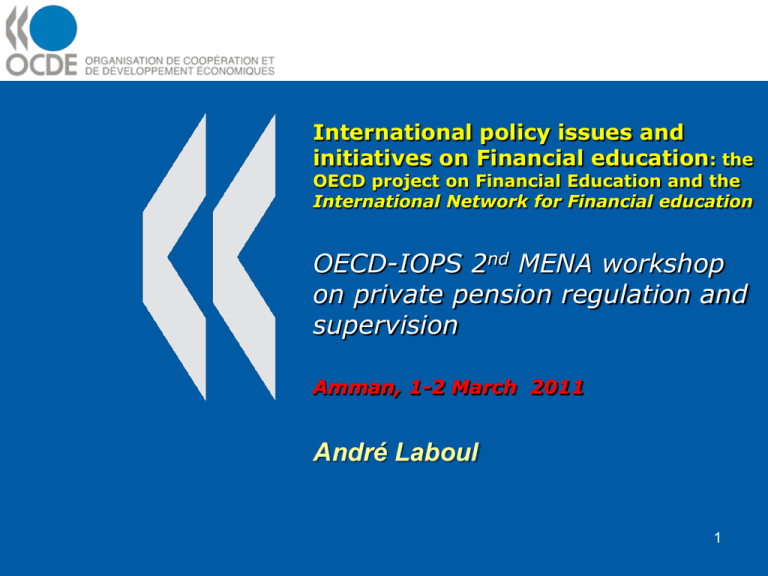Update of OECD Project on Financial Education
advertisement

International policy issues and initiatives on Financial education: the OECD project on Financial Education and the International Network for Financial education OECD-IOPS 2nd MENA workshop on private pension regulation and supervision Amman, 1-2 March 2011 André Laboul 1 Outline • I. International financial education issues • The framework • Calling for financial education • International responses: The OECD and INFE programme • Need for an integrated approach • II. Selected pension issues 2 Selected International Trends • Increasing financial risks ( financial crisis) • Access and inclusion issues (vulnerable groups) • Increased sophistication • Increased transfer of risk to households who are taking on more financial risk and responsibility. This is true for instance for both credit decisions (mortgage ), and retirement savings (DC schemes). 3 Increasing financial risks and transfer of risks to households • This calls for a new regulatory approach • New focus on market conduct and not only on prudential regulation • Focus on financial education but also access and consumer protection • Awareness is key 4 Lack of awareness • The problem is indeed that households may not be aware of the risk they face • Households may not understand the need to be protected or overestimate their protection and their understanding • Thus, they do not seek protection • and may…just not care Call for further information and awareness • Transparent information and disclosure is key. This is the minimum • Information should be understandable; plain language should be used • “Less is more”: danger of overinformation • Information is necessary but not sufficient: individuals need to understand the information 6 Call for financial education – Many individuals are ill-equipped to face risks and make proper financial decisions – This calls for improved financial education and awareness on • Risks • Financial ,pensions , insurance products • Their rights and responsibilities – The goal of financial education (a process) is to improve financial literacy (the result) Broader impact of financial education • Financial education will help build more efficient financial markets by: —improving confidence —encouraging the development of new products and services —and thus increase competition, innovation and product quality • Financial education can also help to reduce poverty and improve social cohesion The situation is serious • Recent surveys show that the level of financial education is low in most countries, including in developed countries. • Worse: consumers often overestimate their financial understanding and thus do not seek to improve it • This is all the more important as the process of financial education takes time • Financial education is not just for investors. It is essential for the average family trying to balance its budget, save for children’s education and save for retirement Solutions are encouraging • We have found that good financial education programmes are effective: they can increase workers participation in pension plans, reduce mortgage and credit delinquency, and more generally, increase consumers confidence in themselves and in financial institutions. A role for all stakeholders • Governments and financial authorities (key role of central banks in several countries) working hand in hand with parliament (including national campaigns, coordination) • Schools • Financial institutions • Employers • Trade unions • NGO’s, etc. There is a strong call for national strategy and public-private partnership 11 Win-win strategy for financial industry • When objectively promoting financial education and awareness, financial institutions help: • Improve confidence and trust in financial markets, products and institutions • Improve risk awareness and thus increase demand for protection • Improve understanding of products and their advantages and thus increase demand • Reduce losses through better prevention and mitigation 12 Momentum due to financial crisis • Findings from a survey conducted through the International Network for financial Education – Lack of financial literacy is one of the contributors to the crisis and in particular of its aggravation – The crisis and its consequences have highlighted the need for enhanced level of accountability of financial institutions vis-à-vis their clients and consumers – They have also raised awareness on the need for increased financial literacy and capability of households and policymakers – The crisis is a « teachable moment » – The crisis is a trigger for policy actions in the financial education area OECD and INFE programme on financial education • Recognising the need for policymakers and other relevant stakeholders to meet the objective of improving financial education, the OECD launched in 2oo3 its “international programme on financial education” • Under the aegis of the OECD Committee on Financial Markets and the OECD Insurance and Private Pensions Committee 14 OECD and INFE programme on financial education • OECD and the network have become the international leader on the development of guidelines and standards in financial education • • • G8 Financial Ministers recognised, in June 2006, OECD work on financial education and requested the Organisation to further develop financial literacy guidelines based on best practices recently supported by policymakers like Secretary of US Treasury, the Council of the European Parliament , the governor of Reserve bank of India or the Mexican Minister of Finance new G20 mandate (in Seoul and Paris) for FSB, with OECD and others to report to G20 2011 summit on policy options to enhance financial consumer protection and education and for OECD, FSB and others to develop principles for the G20 FM and CBG meeting 15 Outputs • Several publications – the first international survey on financial literacy – Report on financial literacy in insurance – Report on financial literacy in pensions – Research on behavioral issues in financial education, on annuities, communication – Stocktake on methodology, financial education at school – etc • An international definition focusing on a capacity building process OECD Principles on financial education: a selection • Financial education programmes should focus on high priority issues (credit, debt, pensions, etc) • Financial education should be taken into account in the regulatory and administrative framework and considered as a tool to promote economic growth, confidence and stability, together with regulation of financial institutions and consumer protection . • National campaigns should be encouraged to raise awareness of the population • Financial education should start at school. People should be educated about financial matters as early as possible in their lives (see session VI on financial literacy as a life skill to be integrated in schools) OECD Principles on financial education • The role of financial institutions in financial education should be promoted and become part of their good governance with respect to their financial clients. Financial institutions’ accountability and responsibility should be encouraged not only in providing information and advice on financial issues, but also in promoting financial awareness of their clients, especially for longterm commitments and commitments which represent a substantial proportion of current and future income. (see session V on social responsibility of the financial sector) • The development of methodologies to assess existing financial education programmes should be promoted. Official recognition of financial education programmes which fulfil relevant criteria should be considered. • . 18 OECD Principles on financial education • In order to take into account the diverse backgrounds of investors/consumers, financial education that creates different programmes for specific sub-groups of investors/consumers (i.e. young people, the less educated, disadvantaged groups) should be promoted.. • According to the needs of the jurisdiction, evaluation processes should inter alia involve: Evaluation on a more systematic basis of the risks, of the population’s degree of literacy, of the education needs 19 OECD good practices (building on comparative analysis) • Good practices for financial education on pensions ( 2008) • Good practices for risk awareness on insurance (2008) • Good practices for Financial education on credit (2009) • More to come (e.g on financial education at school 2011) Worldwide reach • Setting up of the International governmental network for financial education: • members from more than 150 institutions representing 75 countries and international bodies • International Meetings in Washington, Bali, Paris, Rio de Janeiro, Rome, Beirut ; next will include, Canada, South Africa, United Kingdom • Regional programmes currently under development in South East Asia, central Europe, MENA and Latin America • MoU with countries (for instance Indonesia) INFE Subgroups • The measurement of financial literacy and inclusion • The evaluation of financial education programmes – It is important to provide financial education, however it is essential to provide efficient and effective financial education programmes. • Financial education at school • The development of national strategies and related issues • Future sub group on financial inclusion/access (but avoiding duplication) • Future sub group on financial education and women 22 OECD/INFE work • work on pensions issues, which will be undertaken by the OECD in co-operation with the IOPS • work on credit, savings, investment with the objectives to develop guidelines ; work on the role of financial intermediation in the financial education process • work on behaviour economics (essential to develop adequate financial education strategies) • Work on communication/awareness campaigns, social marketing and development of appropriate related tools • Work on vulnerable groups • the development of the financial literacy option in PISA 2012 (support through the subgroup on financial education programmes in schools); • Review and adaptation of current guidelines 23 International dissemination • Conferences/presentations all over the world: Brazil, Columbia, Egypt, France, Hong Kong, Hungary, India, Indonesia, Malaysia, Mexico, Russia, Singapore, Turkey, UK, USA • Issue a newsletter, several publications • Co-operation with other international organisations (IMF, EU, IOPS, FinCoNet etc.), including a close cooperation with the WB • Setting up of an international Gateway at www.financial-education.org, (currently in upgrading phase) International Gateway on financial education www. Financial-education.org Financial education is not enough: necessary…but not sufficient – Other measures are needed to overcome consumers myopia and passive behaviour – To deal with fraud, miss-selling – To protect consumers against bankruptcies – And more generally to protect consumers’ rights Financial education: part of a system (pension example) Ensuring Adequate Retirement Income Regulation Financial Education Other Approaches Consumer protection Provision Of Information Management of Investment Funds Awareness Information Content and Delivery Behavioural Characteristics Of Consumers Instruction Advice Automatic Enrolment Financial consumer protection • Financial education and financial consumer protection are closely linked • OECD 2009 survey on financial consumer protection • Policies focus mainly on disclosure (which thus call for education) • Need to test relevance of existing disclosure • Less is more • Other tools explored in some countries • Importance of adequate redress mechanisms 28 Integrated pillars • Access and inclusion • Prudential regulation and enhanced governance • Consumer information and protection • Competition • Financial education and awareness They are interconnected and interactive 29 Conclusion of the first part • In the framework of increasing risks and increasing transfer of risks, of gaps in coverage and lack of education and awareness; there is a strong need for improving financial education and awareness – This process calls for national strategies, public-private partnership and important role of NGO – It should start at school – Is should deal with priority areas such as pensions, credit, savings and risk awareness – It should allow for special role by financial institutions whose responsibility should be encouraged – it should address vulnerable groups – It calls for efficient education and methodology to measure both literacy and efficiency of the programmes – Financial education is indispensable but financial education alone is not the panacea; it is part of a wider policy approach, complementing prudential regulation and calling for consumer protection – It calls for a worldwide approach 30 Pensions • Awareness: national campaigns • DC schemes – Communication – Financial education • Financial consumer protection 31 Dedicated work on financial education and awareness for pensions and insurance • Started in 2006 on the recommendation of the OECD Council • Complement the OECD general work and recommendation on principles and good practices for financial education and awareness • Developed by the OECD Insurance and Private Pensions Committee and Working Party on Private Pensions • Involved broad consultation of a wide variety of stakeholders Adoption by the OECD Council in April 2008 of 2 Recommendations on Good Practices for : • Financial Education relating to Private Pensions • Enhanced Risk Awareness and Education on Insurance Issues Publication of Improving Education and Awareness on Insurance and Private Pensions, 2008 32 National campaigns • Most of the OECD countries are facing the challenge of how to maintain sustainable pension systems in the face of aging populations. Many have undertaken pension reforms – which frequently involve the introduction of policies which may be seen as unpalatable to parts of the population. These reforms also often involve individuals having to take more responsibility for saving for and funding their retirement income. • Several OECD governments have therefore launched public awareness campaigns to help explain to their populations the need for reforms, the policy undertaken and the increased responsibilities which individuals have for funding their own retirement. • This report contains a review of some of the main campaigns that have been launched in OECD and selected non-OECD countries and provides a preliminary assessment of their effectiveness in terms of extent to which original goals were achieved. Case studies include a comparison between CEE countries, as well as Ireland, Sweden, Singapore and others 33 34 35 36 Initial conclusions / good practices – – – – – – – – – – – – – – Governments first need to define their role in the campaign (which should focus on explaining systematic change and building confidence) When explaining reforms of a pension system objective information is essential Government campaigns work when they clearly distinguish between information and advice To be successful governments need work with many partners and to use varied channels Building on existing financial education work and campaigns can boost effectiveness Governments need to coordinate their campaigns carefully with these other stakeholders – particularly private sector advertising Campaigns may be divided into different stages – e.g. an initial stage may choose to focus on opinion leaders, who can subsequently provide independent information /advice to others Governments may include an element of targeting journalists in the media in their campaigns – with these groups then able to explain reforms to the broader population. For campaigns to work they should not only target older people – information needs to be delivered to those still working and the young. People need a unified picture of their pension options – hence projections are important Governments should not shy away from linking pension reform to other topics – such as labour market issues (e.g. need to work longer) To have the long lasting impact aimed at, campaigns need to be on-going The impact of campaigns needs to be regularly evaluated Behavioural economics shows that some groups will not or cannot save and governments should therefore consider linking their campaigns with other mechanisms (e.g. automatic enrolment and well designed default options) 37 Defined contribution schemes • DC schemes transfer longevity and investment risks on individuals • This affects investment choice but also level of contribution • Call for proper communication • Call for financial education 38 Communication • • • • • The importance of DC pensions is growing rapidly DC plans require individual members to bear significant risks to take a much more active role in managing their pension savings than would be the case in a traditional DB pension To successfully manage risks, individuals need to understand both the nature of their pension plans and their responsibilities and to receive periodic and recurring updates on the status of their pension savings. Such updates are typically provided by the pension statement. Policymakers, plan sponsors and plan members generally agree that communicating pension benefits in a clear, understandable and timely manner benefits all stakeholders, yet there is little consensus as to what information should be included or excluded from the pension statement or how that information should be presented. The main purpose of this project is to assess what countries include in their pension statements, discuss its design, what information it should include in order to most effectively communicate information about members’ pension benefits and how the statement can help the encourage greater savings 39 40 41 Good Practices on Financial Education relating to Private Pensions Rationale: 1. Unique nature of the pensions product makes financial education particularly important… Long-term nature of contract, complex products, wide social coverage, low risk tolerance, large number of pension schemes, potential impact on financial markets and economy 2. ….Combined with demographic and systematic trends: Increased longevity , shorter working lives, lower birth rate, Decline in public pensions, shift from DB to DC schemes 3. Lack of financial knowledge relating to pension: Lack understanding of the changing retirement environment, of the need to save, of investments, lack of trustee and fiduciary capability, passive behaviours and individual choice 42 Good Practices on Financial Education relating to Private Pensions Key messages : Role of governments : Explaining the interaction between public and private sources of etirement income Informing on pension reform and other relevant evolutions Ensuring the provision of sufficient, practical and simple information on pension issues and pensions projection in particular Importance of national campaigns and school programmes, evaluation process Specific needs of members of DC schemes Role of key stakeholders : plan sponsors, pension funds, fiduciaries, intermediaries, social partners Financial education limits: importance of disclosure, limited choice, automatic enrolments, default options 43 Integrated approach • Information, communication, financial education: necessary but not sufficient • Behavioral factors • Default mechanisms • Move option from opt in to opt out • Need also for consumer protection 44 OECD Core Principle 5: Rights of members and beneficiaries and adequacy of benefits • Non-discriminatory access should be granted to private pensions schemes. Regulation should aim at avoiding exclusions based on age, salary, gender, period of service, terms of employment, parttime employment, and civil status. It should also promote the protection of vested rights and proper entitlement process, as regard to contributions from both employees and employers. Policies for indexation should be encouraged. Portability of pensions rights is essential when professional mobility is promoted. Mechanisms for the protection of beneficiaries in case of early departure, especially when membership is not voluntary, should be encouraged. 45 OECD Core Principle 5: Rights of members and beneficiaries and adequacy of benefits • Proper assessment of adequacy of private schemes (risks, benefits, coverage) should be promoted, especially when these schemes play a public role, through substitution or substantial complementary function to public schemes and when they are mandatory. Adequacy should be evaluated taking into account the various sources of retirement income (tax-and-transfer systems, advance-funded systems, private savings and earnings). • Appropriate disclosure and education should be promoted as regards respective costs and benefits characteristics of pension plans, especially where individual choice is offered. Beneficiaries should be educated on misuse of retirement benefits (in particular in case of lump sum) and adequate preservation of their rights. Disclosure of fees structure, plans performance and benefits modalities should be especially promoted in the case of individual pension plans. 46 implementation – Access to plan participation, equal treatment and entitlements under the pension plan • Employees should have non-discriminatory access to the private pension plan established by their employer. Specifically, regulation should aim at avoiding exclusions from plan participation that are based on non-economic criteria, such as age, gender, marital status or nationality. In the case of mandatory pension plans, those plans that serve as the primary means of providing retirement income, and those that are significantly subsidised by the state, regulation should also aim at avoiding other unreasonable exclusions from plan participation, including exclusions based on salary, periods of service and terms of employment, (e.g., by distinguishing between part-time and full-time employees or those employed on an at-will and fixed-term basis). Regulation of voluntary and supplementary pension plans also should aim towards similarly broad access, although the extent of such access may take into account factors including the voluntary nature of the arrangement, the unique needs of the employer establishing the pension plan, and the adequacy of other pension benefits 47 implementation • Benefit Accrual and Vesting Rights Accrued benefits should vest immediately or after a period of employment with the employer sponsoring the plan that is reasonable in light of average employee tenure. Benefits derived from member contributions to the pension plan should be immediately vested. • Pension portability and rights of early leavers • Disclosure and availability of information • Additional rights in the case of member-directed, occupational plans • Entitlement process and rights of redress 48 IOPS Financial Education Project • IOPS project will focus on the role of pension supervisory authorities in providing information and education to members of pension funds – Part I will examine campaigns run by pension supervisory authorities in response to the financial crisis stressing how pension savings are long-term and attempting to preserve confidence in pension systems – Part II looks at the types of comparative data on performance and costs which are provided by pension supervisory authorities to help individuals choose between providers – Part III looks at some innovative financial education campaigns which are being run by supervisory authorities in countries such as Chile, Kenya, Singapore and Turkey 49 50 THANK YOU more information at: www.oecd.org/daf/financialeducation and www.financial-education.org 51







